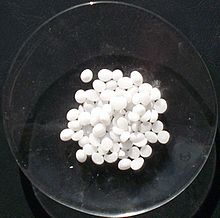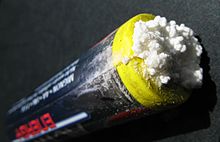Potassium hydroxide
Potassium hydroxide is an inorganic compound with the formula KOH, and is commonly called caustic potash.In the case of methanol the potassium methoxide (methylate) forms:[15] Because of its high affinity for water, KOH serves as a desiccant in the laboratory.KOH, like NaOH, serves as a source of OH−, a highly nucleophilic anion that attacks polar bonds in both inorganic and organic materials.This reaction is manifested by the "greasy" feel that KOH gives when touched; fats on the skin are rapidly converted to soap and glycerol.The salt metathesis reaction results in precipitation of solid calcium carbonate, leaving potassium hydroxide in solution: Filtering off the precipitated calcium carbonate and boiling down the solution gives potassium hydroxide ("calcinated or caustic potash").The potassium salts of carbonate, cyanide, permanganate, phosphate, and various silicates are prepared by treating either the oxides or the acids with KOH.[19] Aqueous potassium hydroxide is employed as the electrolyte in alkaline batteries based on nickel-cadmium, nickel-hydrogen, and manganese dioxide-zinc.The FDA considers it generally safe as a direct food ingredient when used in accordance with Good Manufacturing Practices.[23] Entomologists wishing to study the fine structure of insect anatomy may use a 10% aqueous solution of KOH to apply this process.[24] In chemical synthesis, the choice between the use of KOH and the use of NaOH is guided by the solubility or keeping quality of the resulting salt.The hides are soaked for several hours in a solution of KOH and water to prepare them for the unhairing stage of the tanning process.




IUPAC nameCAS NumberChemSpiderECHA InfoCardEC NumberE numberPubChemRTECS numberUN numberCompTox DashboardSMILESChemical formulaMolar massdeliquescentDensityMelting pointBoiling pointSolubility in waterSolubilityalcoholglycerolammoniamethanolisopropanolAcidityMagnetic susceptibilityRefractive indexHeat capacityStd molarentropyStd enthalpy offormationGHS labellingPictogramsHazard statementsPrecautionary statementsNFPA 704Flash pointSafety data sheetanionsPotassium hydrosulfidePotassium amidecationsLithium hydroxideSodium hydroxideRubidium hydroxideCaesium hydroxidePotassium oxidestandard stateinorganic compoundstrong basetonnesthermal stabilityhygroscopicdissolutionexothermiccrystallizescrystal structurehydratesdissolvealcoholsethanolpropanolssolventsmethoxidedesiccantaminespyridinesnucleophilicpolar bondssaponifiesesterspotassium soaphalidesleaving groupsaromaticreagentsphenolsoxidescarbon dioxidepotassium bicarbonatepotassium carbonatecalcium hydroxidesalt metathesis reactioncalcium carbonatepotassium chloridechloralkali processHydrogencathodechloridechlorinecoke (fuel)supercriticalcarbon monoxidemethanepressure swing adsorptionpower-to-gascarbonatecyanidepermanganatephosphatepotassium phosphatefertilizerssaponificationAqueouselectrolytealkaline batteriesnickelcadmiummanganese dioxidenickel–metal hydride batteriesToyota PriusNickel–iron batteriesGood Manufacturing PracticesresomationEntomologistsinsectanatomydisinfectcorrosionmanicurecuticletanninggilled mushroomsboletespolyporeslichenscaustic